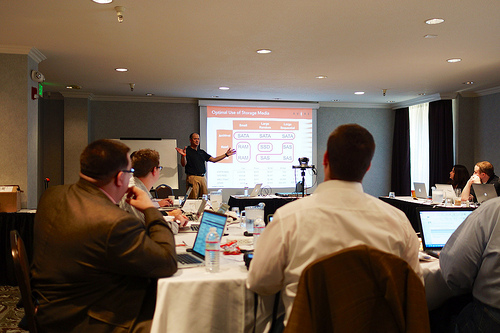I really enjoy Marco Arment‘s blog and the links he posts and comments on. And I recently read his post, “We’re Just Flipping Through Index Cards”, with a reference to a podcast interview John Roderick by Myke Hurley that got me thinking. John is talking about the music industry, and Marco is talking about the app store. But a lot of it rings true for enterprise IT, too.

PR Before the Internet
Here’s an example, thanks to Marco’s transcript:
[Ten years ago,] you were dependent on this whole cultural architecture of magazine writers, newspaper writers, college radio, commercial radio, public radio… and if your record got into the stream, and the right person liked it and talked about it, then pretty soon you’ve created a storm of interest that started with one or two people who decided that this record was something that really mattered.
Now substitute “tech press” and “tech analysts” for the influencers he’s referring to and you see where I’m going with this. It used to be that corporate PR could focus on a few well-known individuals to get their message out, just like the music industry focused on DJs and music writers.
I was one of those writers near the tail end; my friend Howard Marks was there in the thick of it. He tells tales of magazines so thick with ads they had to pay extra for articles just to meet postal service “minimum content” rules! And Gartner was the strongest force in the enterprise IT space, with end users paying for their recommendations and following them to the letter.
Democracy Wins!
But that’s all gone now. Storage Magazine folded, and only a few publications remain professional, relevant, and useful (hello, Network Computing!) Even conferences have changed, with independent shows being replaced by vendor-controlled events.
Where do end users go for advice and information about new products? And where to corporate PR and marketing folks go to talk about their wares?
John continues:
Well, five years ago, all of a sudden the conventional wisdom started to change. “Oh, no, we don’t have to do any of that anymore! You just put it on the internet, everybody listens to it, and ‘the crowd’ decides! And you don’t have to do any of that bullshit anymore. You can just tweet about your record, and everybody’s going to listen to it and love it!”
And for a brief moment, when the internet was still comprised mostly of all the right people, it was just the cool kids that were on there. Clap Your Hands Say Yeah could put out a record on Myspace, and the cool kids would all get it.
That was the enterprise IT world about 5 years ago when we started Tech Field Day. A few of us had made the jump to the Internet, and some great new folks started to appear. And what we said mattered just because someone was there, and they were saying something.
Another great thing happened thanks to the Internet (especially blogging and Twitter): Techies became influencers. The old guard ignored the Internet at first. Then they tried to firewall their content and make people pay. Then their empires collapsed. Content was king and democracy won, for a while at least.
What Now?
But in the last few years, things have been changing. Everyone is on Twitter and “social media professionals” have been gaming the system long enough that link fatigue is setting in. Here’s John again:
But, of course, that window was short-lived. Now, we’re back to a world where everybody’s on the internet, and nobody cares. Nobody’s following your tweet link to your record anymore! Except your fans, people who already like you.
My Twitter feed is now 85% links to people’s Kickstarters and YouTube videos. And I only follow people I know! Imagine following your favorite bands — it would be never-ending. Everybody’s trying to promote themselves the same way.
The problem is now, if you hire a publicist, what are they doing? They’re just tweeting about it, too, because the magazines are gone, the record stores are gone… it’s anybody’s guess how to promote a record now. …
I’m sure this sounds familiar to enterprise IT PR and marketing folks. They fill their corporate Twitter accounts with links but get few tweets. They try to build up their Facebook pages because that’s what the pros say to do, but have precious little actual engagement. And they’re inundated with potential social media outlets, from tweeters to online publications to events. But there’s just too much chaff and not enough wheat!
It’s Not the End of the World
In that podcast, John bemoans the decline he sees in the quality of music today, seemingly blaming it on this noisy social media world. I don’t agree.
I only heard John’s views because Marco blogged it. He presumably only heard it because he listens to CMD+Space and respects Myke. And I only listen to Marco because he has a history of posting quality content. See where this is going?
Social media is increasingly filled with noise like the Kickstarter and YouTube links John bemoans. But this just makes it more important to build a reputation and real relationships. “Followers” and “likes” are irrelevant if they’re hollow, and these are proliferating. But nothing can take the place of real credibility. People like Marco, Myke, and John are more important than ever, and they do make a real impact on opinions.
What We’re Doing
The same is true for PR in enterprise IT. You can’t just hire self-proclaimed social media experts and build followers. You can’t trust generic social media metrics without context. You have to build real relationships and have credible conversations with people that are respected in your space. These are the new writers and analysts.
One of the hardest parts of planning Tech Field Day is saying “no” to people we like. We know dozens of great folks in wireless, storage, networking, and the rest, but only a few can go to each event. It’s heartbreaking to tell folks they can’t come this time, but this is what we have to do. Tech Field Day wouldn’t work with 30 people in the room (we’ve tried!) so we have to pick just a few key folks. And our presenters love knowing that they’re reaching top people in their specific area of focus, chosen by their peers.
What makes Gestalt IT, Foskett Services, and Tech Field Day different is us. We’re not some generic social media company. We’re the audience as well as the speaker. We’re enterprise IT people and we would not do this if we didn’t love it. We believe we’re doing the “good work” John is looking for in the music industry: Setting up real conversations and building real connections in an open and democratic way.






